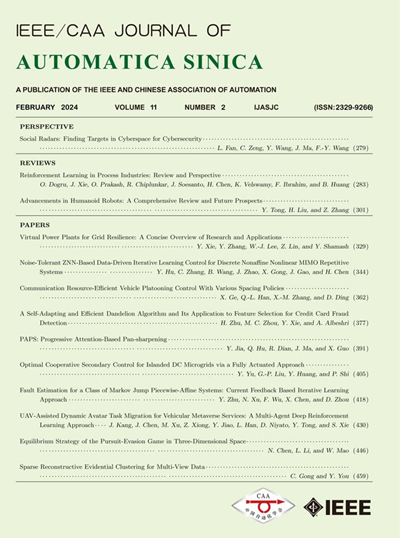可解释的数据驱动学习与快速超声检测电池健康估计
IF 19.2
1区 计算机科学
Q1 AUTOMATION & CONTROL SYSTEMS
引用次数: 0
摘要
健康管理对于确保电池的性能和安全至关重要,而数据驱动的学习系统是一个很有前途的解决方案,可以实现锂离子(Li-ion)电池的有效健康状态(SoH)估计。然而,信号数据采集耗时长,模型缺乏可解释性,仍然阻碍了其有效部署。受此启发,这封信通过结合可解释的人工智能和无损超声检测对电池SoH估计的好处,提出了一种新颖且可解释的数据驱动学习策略。具体而言,在为电池配备先进的超声波传感器以保证快速实时超声信号测量后,设计了一种可解释的数据驱动学习策略,称为广义加性神经决策集成(gade),以快速估计电池SoH并解释所涉及的超声特征的影响。具体来说,gade是由改进的广义可加模型(GAM)和神经无关决策集成(NODE)衍生而来,改进的GAM具有清晰的可解释性,而NODE提供了优越的估计性能。结果表明,gade对电池SoH的估计结果令人满意,R2大于0.97。此外,四种超声特征对SoH估计结果的影响可以很好地解释和可视化,这极大地有利于模型决策的理解和电池系统的控制与优化。本文章由计算机程序翻译,如有差异,请以英文原文为准。
Interpretable Data-Driven Learning with Fast Ultrasonic Detection for Battery Health Estimation
Dear Editor, Health management is essential to ensure battery performance and safety, while data-driven learning system is a promising solution to enable efficient state of health (SoH) estimation of lithium-ion (Li-ion) batteries. However, the time-consuming signal data acquisition and the lack of interpretability of model still hinder its efficient deployment. Motivated by this, this letter proposes a novel and interpretable data-driven learning strategy through combining the benefits of explainable AI and non-destructive ultrasonic detection for battery SoH estimation. Specifically, after equipping battery with advanced ultrasonic sensor to promise fast real-time ultrasonic signal measurement, an interpretable data-driven learning strategy named generalized additive neural decision ensemble (GANDE) is designed to rapidly estimate battery SoH and explain the effects of the involved ultrasonic features of interest. Specifically, GANDE is derived from improved generalized additive model (GAM) and neural oblivious decision ensemble (NODE), with improved GAM enabling clear interpretability, while NODE provides superior estimation performance. Results illustrate that the GANDE presents satisfactory battery SoH estimation results with R2 over 0.97. In addition, the effects of four ultrasonic features on SoH estimation results can be well explained and visualized, which greatly benefits the understanding of the model's decision making and the control and optimization of battery systems.
求助全文
通过发布文献求助,成功后即可免费获取论文全文。
去求助
来源期刊

Ieee-Caa Journal of Automatica Sinica
Engineering-Control and Systems Engineering
CiteScore
23.50
自引率
11.00%
发文量
880
期刊介绍:
The IEEE/CAA Journal of Automatica Sinica is a reputable journal that publishes high-quality papers in English on original theoretical/experimental research and development in the field of automation. The journal covers a wide range of topics including automatic control, artificial intelligence and intelligent control, systems theory and engineering, pattern recognition and intelligent systems, automation engineering and applications, information processing and information systems, network-based automation, robotics, sensing and measurement, and navigation, guidance, and control.
Additionally, the journal is abstracted/indexed in several prominent databases including SCIE (Science Citation Index Expanded), EI (Engineering Index), Inspec, Scopus, SCImago, DBLP, CNKI (China National Knowledge Infrastructure), CSCD (Chinese Science Citation Database), and IEEE Xplore.
 求助内容:
求助内容: 应助结果提醒方式:
应助结果提醒方式:


